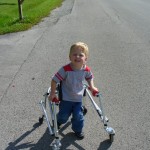
Special Needs Conditions and where to find help in NJ
To say a child was born with special needs is rather vague and inaccurate. Each child who lives with special needs was born with, or developed, a specific condition or disorder and the proper way to refer to their needs is to say that they have “this (name) disorder” or “that (name) condition.”
The complete list of special needs conditions and disorders is rather large and it is nearly impossible to name them all. The easiest way to understand the majority of the conditions is to first categorize them. Some children may have social and communication conditions while others were born with chromosomal disorders, neurological disorders, mobility disorders or developmental conditions. Below you will find a brief description of many common conditions that classify a child as having special needs.
The Most Commonly Special Needs Genetic Condition: Down Syndrome
One condition that many people have heard of is Down Syndrome. This is a disorder caused by a mutation of chromosome 21 where they either have a partial or total duplication of and the genetic information.
This is also the most common genetic condition in the United States, affecting 1 in every 691 babies each year. To look at this differently, there are currently 400,000 people living with Down Syndrome in the US and 6,000 people are diagnosed with the condition each year.
Those who live with it often experience intellectual and developmental delays. Despite these delays, children who have Down Syndrome are oftentimes happy, friendly and energetic. They are loving, caring and always happy to help others and be included.
Types of Down Syndrome
There are three different types of Down Syndrome and each one, while similar in some ways, presents itself in a uniquely defined fashion that separates it from its sister conditions.The way in which each diagnosis is made depends upon the level of chromosome 21’s duplication.
Trisomy 21: Also called Nondisjunction, this type of Down Syndrome is characterized by a third copy of chromosome 21. While everyone is born with two copies of the twenty first chromosome, a third copy can cause typical indications of this condition. 95% of cases are diagnosed with Trisomy 21.
Mosaicism: This type of Down Syndrome occurs when nondisjunction of chromosome 21 takes place in only one of the initial cell divisions after fertilization. This means that the person has 47 chromosomes instead of the usual 46 and will likely have less physical characteristics of Down Syndrome. Mosaicism only affects 1% of Down Syndrome cases in the US.
Translocation: Affecting 4% of the diagnosed Down Syndrome cases, translocation is defined by part of chromosome 21 breaking off during cell division and attaching itself to chromosome 14. It is this extra part of chromosome 21 that causes the well-known characteristics of the disorder.
Other Common Special Needs Conditions
Fragile X Syndrome
Commonly referred to as FXS, people living with Fragile X Syndrome often have behavior and learning challenges, a variety of physical impairments and intellectual disabilities. While both genders have a chance of getting FXS, males are often affected more.
Physical characteristics of someone with FXS often include longer faces, slightly larger ears, softer skin and connective tissue problems that present as ear infections, hyperflexible joints, double jointed fingers and a high arched palate.
Females who are diagnosed with FXS often present with milder symptoms meaning their intellectual disabilities are not as severe and they do not have as many emotional or behavioral challenges. However, they may have general or social anxiety as well as mental health issues.
For a highlight of the Fragile X Foundation in NJ, click here.
Angelman Syndrome
Occurring in 1 in 15,000 live births, Angelman Syndrome (AS) is characterized by seizures, lack of speech, developmental delays and walking or balance disorders. It is an extremely rare neuro-genetic condition often misdiagnosed as autism or cerebral palsy due to a lack of awareness.
Although children with AS live with the challenges of not being able to speak or having limited speech, experience numerous seizures and have developmental delays, they are often happy and laugh a lot.
Cystic Fibrosis
Cystic Fibrosis (CF) is a genetic disease often classified as life threatening because those who have it suffer from clogging of the lungs and obstruction of the pancreas, preventing the proper breakdown of food and absorption of vital nutrients.
While there have been many strives in the treatment of CF throughout the years, there still is no cure for the disease. Patients often need multiple lung treatments a day and, even with those treatments, the life expectancy is still, unfortunately, only in the 30’s and 40s.
Sotos Syndrome
This genetic condition is recognized by a physical overgrowth during the first year of a person’s life. People with this condition are often bigger, both in height and weight, have larger heads and have delayed social, motor and cognitive development.
Unlike many genetic conditions that can be diagnosed from day one, Sotos Syndrome often goes undiagnosed for months, and sometimes years. However, late diagnosis does not necessarily mean a grim prognosis.
As children with Sotos Syndrome age, the developmental gap between the child and their peers begins to disappear. Once weak muscle tone begins to improve as the years pass, speech becomes better and many adults with this condition fall within normal weight, height and intellectual ranges.
Dyspraxia
Beginning in childhood and following a person into adulthood, dyspraxia is a developmental coordination disorder (DCD) that affects both fine and gross motor skills. People with this disorder often have difficulty crawling and walking.
Although the cause of dyspraxia has yet to be confirmed, it is believed that dyspraxia results from an interrupted signal between the brain and the body. In other words, the brain attempts to send the legs a message to walk, but the message is only partially received because the message path is blocked.
Verbal Dyspraxia
Like dyspraxia, verbal dyspraxia is a neurological condition in which a person is unable to properly move the muscles of their mouth to speak. While there is usually not any physical damage to the muscles, the message from the brain is interrupted or lost.
Some symptoms of verbal dyspraxia include an inability to speak, repeating one sound over and over when the use of another sound is desired, an inability to sustain common intonational patterns and speaking slowly with more pauses than other people.
Tourettes Syndrome
Probably the most well-known Tic-Disorder, Tourette Syndrome is a hereditary neurological condition affecting the ability to speak. People with this condition will often find themselves making unwanted movements and repeating pieces of speech multiple times.
Unlike years ago, people living with Tourette Syndrome today have a lot of support. There are regional and national foundations, all working towards a cure so people do not have to deal with the frustrations of communicating and the pain caused by tics.
Cerebral Palsy
Cerebral Palsy(CP) is a mobility disorder caused by malformation of the brain. This disorder can affect both muscle and intellectual abilities. People living with this condition will have either partial or complete paralysis of either one or both arms and legs and can have intellectual delays that follow them through life.
One plus of this condition is that CP does not worsen over time; it can only be improved. As a result, it is highly recommended that parents, upon learning of their child’s diagnosis, seek treatment options earlier rather than later. The earlier the treatment, the better the chance of improvement.
Common treatments for CP are occupational therapy, speech therapy and physical therapy. Considering the condition affects muscle use, these therapies can help strengthen and fine tune movements. While the signal to and from the brain cannot be repaired, children can learn how to adapt and complete tasks in different ways.
Currently there is no cure for CP because it is caused by brain malformation and paralysis of nerves, however, researchers are continuously working to understand genetic, environmental and other factors which contribute to CP’s presence at, or shortly after, birth.
Muscular Dystrophy
This condition occurs when a person experiences weakening or wasting of muscle tissue. This means that a person with this genetic condition may have difficulty, or be incapable of, performing certain tasks because their muscles are abnormally weak. The NJ Muscular Dystrophy Foundation can answer further questions on their website.
Autism
Autism is probably one of the best-known developmental disabilities simply due to its presence in the media and its overwhelming presence in NJ. People living with Autism often have trouble interacting socially, relating to people and communicating. This condition is commonly referred to as a “spectrum disorder” because no one has the same degree of Autism. While one person may be severely affected by the disorder, requiring out-of-home care and many types of therapy, another person may only be mildly affected by the disorder.
People who are only mildly Autistic may actually suffer from Aspergers Syndrome. This is a mild form of the disorder, differing only in the way in which it presents itself. People living with Aspergers Syndrome are likely to have difficulties with social interaction, creative play and communicating. Many people argue that high functioning Autism and Aspergers Syndrome are too similar to differentiate and therefore should be classified as the same condition.
Epilepsy
This is a seizure condition that, depending upon the frequency of seizures, could radically impact a person’s life. Considering a seizure occurs when the brain experiences a large burst of electrical activity, even a few seizures a week could make normal functioning difficult.
If the epileptic seizures are persistent enough, a doctor may prescribe medication. An anticonvulsant such as Trileptal, Lyrica or Tegretol can interrupt the electrical signal in the brain that cause seizures and allow messages to take their intended path. Visit the Epilepsy Foundation of New Jersey for additional information.
Attention Deficit Hyperactivity Disorder
Attention Deficit Hyperactivity Disorder, or ADHD, is a condition which affects a person’s ability to focus and sit still. People living with this disorder are often restless, get distracted easily and may have a few behavioral problems as well.
Falling under of the broad spectrum of Attention Deficit Disorders, ADD, ADHD is unique in the sense that those living with the disorder cannot sit still easily. They fight their body’s urges to constantly move and/or focus on many things at once. In many more severe cases, people are put on medication so they can sit still, focus and keep themselves from distraction.
Deficit in Attention Motor control and Perception
Deficit in Attention Motor control and Perception, or DAMP, is essentially ADHD with a few additional symptoms. People with DAMP not only have trouble focusing and sitting still, but they also have motor skill delays and trouble differentiating between what is seen and what is heard.
Hypomelanosis of Ito
This neurological condition is extremely rare and defined by hypopigmentation of the skin. People with this condition will have whorls of hypopigmented skin on their body and may also experience developmental delays, seizures and other problems. The National Organization for Rare Diseases has more information regarding the causes and treatment of this disorder.
Semantic Pragmatic Disorder
Associated with Autism, Semantic Pragmatic Disorder (SPD), is used to describe children who suffer from some communication difficulties, including an inability to put words together freely, instead speaking in memorized phrases. Those with this condition may in fact have Autism, but the symptoms are not prevalent enough to tell at the time of diagnosis. Doctors often follow these patients closely so as to diagnose any other conditions that may arise later.
Dyslexia
Not linked to the level of a person’s intelligence, Dyslexia simply means that a person has extreme difficulty reading, writing and spelling. Their brain misinterprets the letters, causing them to make mistakes and experience lower grades until proper treatment is received.
Dysgraphia
Much like Dyslexia, Dysgraphia is not related to intelligence. People living with this condition have messy or illegible handwriting because they have trouble writing by hand. Another common characteristic of those with Dysgraphia is the mixed use of upper and lowercased letters.
Hypermobility Syndrome
A person is diagnosed with Hypermobility Syndrome when they have the ability to move joints beyond the expected limitations of movement. Although many people who do not have this condition think it is “cool” or “weird” that someone with Hypermobility Syndrome can bend their fingers, toes or elbows in the opposite direction they are supposed to go, they often overlook that those living with this condition are more susceptible to physical injury.
Although this may not encapsulate every special needs condition defined in a medical dictionary, this list covers quite a few. Whether you are a parent of a child with a certain special needs condition, a medical student looking for a quick overview of disorders or you simply find the medical field fascinating and you are reading this for fun, you have likely learned something and discovered a new world of medicine.
Also see a brief overview of special needs services in NJ.



